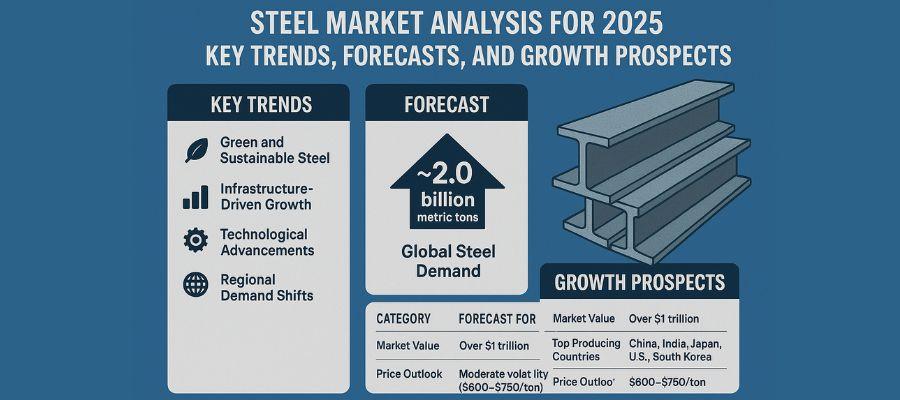The global steel industry stands as the backbone of modern infrastructure, energy, automotive, and construction sectors. As we enter 2025, the steel market is poised for significant transformation, driven by global economic recovery, rising industrial demand, and sustainability initiatives. This blog provides a comprehensive steel market analysis for 2025, highlighting the key trends, forecasts, and growth prospects that will shape the industry.
Current Market Overview
The steel market has shown resilience after recent global disruptions, with steady demand from sectors such as construction, infrastructure, and manufacturing. Emerging economies, particularly India and Southeast Asia, are expected to drive consumption growth due to large-scale infrastructure projects and industrial expansion. Simultaneously, developed economies are focusing on green steel technologies, carbon-neutral production, and circular economy initiatives.
Key Trends in the Steel Market 2025
- Green and Sustainable Steel
With stricter environmental regulations, steel manufacturers are investing in low-carbon production technologies. Hydrogen-based steelmaking and recycling of scrap are becoming major focus areas. - Infrastructure-Driven Growth
Governments worldwide are increasing infrastructure spending. India’s target of becoming the world’s second-largest steel producer and the U.S.’s infrastructure modernisation plan are crucial growth drivers. - Technological Advancements
Automation, digitalisation, and AI-driven production are streamlining operations and improving efficiency in steel plants globally. - Regional Demand Shifts
Asia-Pacific continues to dominate global steel consumption, with China, India, and Japan leading the demand. Meanwhile, African nations are emerging as new markets due to industrialisation. - Price Volatility
Raw material supply fluctuations, energy costs, and geopolitical factors are expected to keep steel prices volatile throughout 2025.
Forecast and Growth Prospects
Industry analysts project that global steel demand will rise steadily in 2025, with emerging economies accounting for the majority of consumption. The global steel market size is estimated to surpass $1 trillion by 2025, supported by rising urbanisation and the shift toward sustainable infrastructure.
Below is a table summarising the steel market forecast for 2025:
Category | Forecast for 2025 | Growth Drivers |
Global Steel Demand | ~2.0 billion metric tons | Infrastructure, automotive, manufacturing |
Market Value | Over $1 trillion | Construction, renewable energy projects |
Top Producing Countries | China, India, Japan, U.S., South Korea | Capacity expansion, exports |
Top Consuming Sectors | Construction (50%), Automotive (15%), Energy (10%) | Urbanization, green energy transition |
Green Steel Adoption | 20–25% of new production lines | Hydrogen tech, carbon-neutral goals |
Price Outlook | Moderate volatility ($600–$750/ton) | Raw material and energy costs |
Challenges Ahead
While the steel industry outlook for 2025 is positive, challenges remain:
- Environmental Concerns: Transitioning to carbon-neutral steel production requires high capital investment.
- Geopolitical Tensions: Trade disputes and raw material shortages may disrupt supply chains.
- Energy Costs: Fluctuating energy prices will impact steelmaking operations.
Conclusion
The steel market in 2025 is set for growth, driven by rising infrastructure investments, demand for sustainable materials, and technological innovations. With global steel demand expected to reach around 2 billion metric tons and the market value crossing $1 trillion, the sector presents vast opportunities. However, producers and investors must navigate environmental challenges and market volatility strategically.
As the world moves toward a greener economy, steel will remain a critical foundation of global development, shaping industries, economies, and the future of sustainable growth.
For updates and additional information, follow on social media platforms.
Social Media: LinkedIn, Instagram, Facebook, Pinterest.

